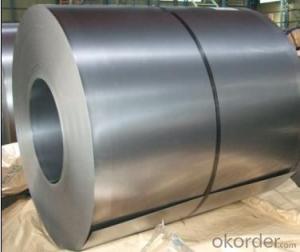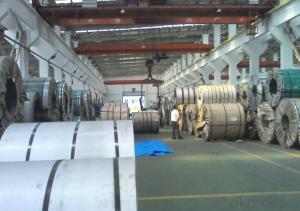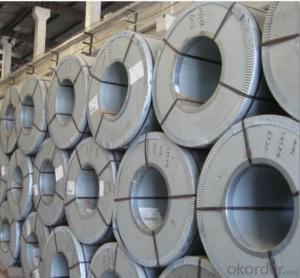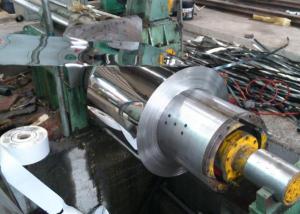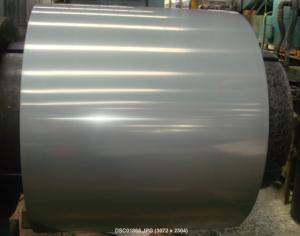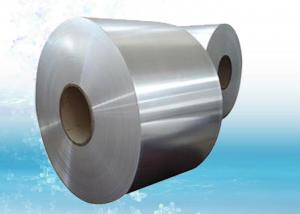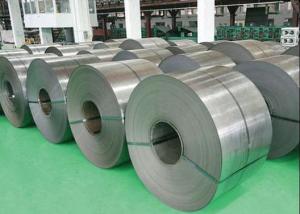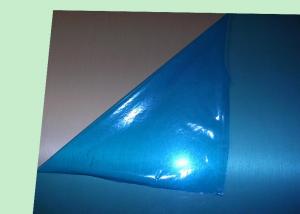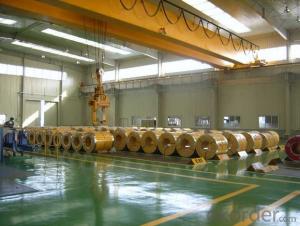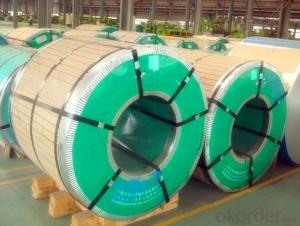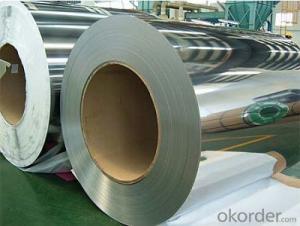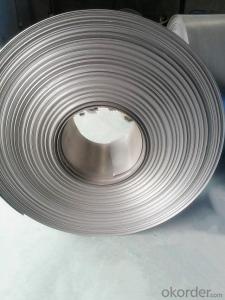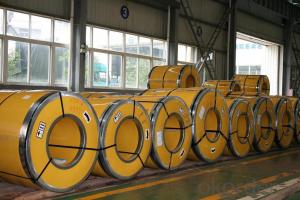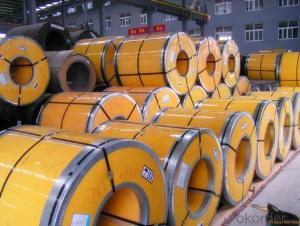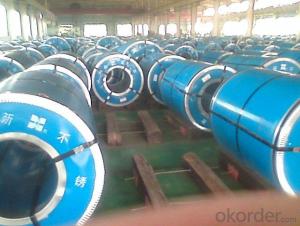304 SERIOUS HOT ROLLED STAINLESS STEEL COILS/SHEETS
- Loading Port:
- Shanghai
- Payment Terms:
- TT OR LC
- Min Order Qty:
- 100 m.t.
- Supply Capability:
- 20000 m.t./month
OKorder Service Pledge
OKorder Financial Service
You Might Also Like
Quick Details
| Grade: | 2B | Standard: | JIS,AISI,GB | Length: | as customers' requested |
| Thickness: | 2.5mm;3.0mm;4.0mm or as required | Width: | 485mm,510mm,600mm or as required | Place of Origin: | Shanxi China (Mainland) |
| Brand Name: | CNBM | Model Number: | 201 | Type: | Coil |
| Application: | Decoration,Boiler Plate,Chemical Industry,Container plate,ship | Certification: | SGS,ISO | Color: | natural color |
| Available Finish: | 2B/BA/8K/No.4/SB/HL | Edge: | slit edge and mill edge | Features: | accurate dimensions |
| Manufacture technology: | cold drawn,pickling, hot rolled and cold rolled | DDQ: | slivery bright surface | Quality: | high quality Hot rolled stainless steel coil 201 |
| Stock: | Always in stock | Item: | Hot rolled stainless steel coil 201 |
Packaging & Delivery
| Packaging Detail: | Standard export packing or as customer's requirement Hot rolled stainless steel coil 201 |
| Delivery Detail: | In 15 days |
Specifications
Hot rolled stainless steel coil 201
Width:485mm,510mm,600mm or as required
Thickness: 2.5mm;3.0mm;4.0mm or as required
Product Description
Stainless steel coil; stainless steel cold rolled coil;201 stainless steel coil; stainless steel coil
A. stainless steel coil
B. with competitive prices and fast delivery
C. High quality
Tisco 201 stainless steel coil
Thickness: 2.5mm;3.0mm;4.0mm or as required
Width: 485mm,510mm,600mm or as required
Length: As required
Material:201
201 stainless steel coil chemical composition
201 stainless steel coil | ||||||||
Grade | Chemical composition | |||||||
C | Si | Mn | P | S | Ni | N | Cr | |
% | % | % | % | % | % | % | % | |
201 | ≤0.15 | ≤0.75 | 5.5~7.50 | ≤0.060 | ≤0.030 | 3.50~5.50 | ≤0.25 | 16.00-18.00 |
201 stainless steel coil physical property
Physical Property | ||||
density | Strength of extension | yield strength | elongation | modulus of elasticity |
g/cm³ | psi | psi | % | psi |
7.93 | 100000-180000 | 50000-15000 | 55-60 | 29000000 |
Item | CNBM 201 stainless steel coil |
Technical | Hot rolled and cold rolled |
Standard | ASTM A240,GB/T3280-2007,JIS4304-2005,ASTM A167,EN10088-2-2005,GB/T3280-2007,EN10095-99,JIS4312,etc |
Material | 201,202,304,304L,309S,310S,316,316L,316Ti,430 |
Surface | NO.1,2b,4K,8k,HL,mirror finish |
Thickness | 0.3-100mm |
Width | 500-2000mm |
Price term | FOB,CFR,CIF |
Application | Stainless steel coil applies to construction field, ships building industry, petroleum, chemical industries, war and electricity industries, food processing and medical industry, boiler heat exchanger, machinery and hardware fields. Stainless steel coil can be made according to the customer’s requirements. |
Contact | If you have any question, please feel free to contact me. |
- Q: What are the advantages of using narrow width 111 stainless steel strips?
- There are several advantages of using narrow width 111 stainless steel strips. Firstly, the narrow width allows for more precise and accurate cutting, making it ideal for applications that require tight tolerances. Secondly, the 111 stainless steel composition provides excellent corrosion resistance, making it suitable for use in harsh environments or applications that involve exposure to moisture or chemicals. Additionally, the narrow width strips are easier to handle and transport, making them more convenient for manufacturers and reducing the risk of damage during transit. Lastly, the narrow width allows for efficient material usage, reducing waste and cost in production processes.
- Q: Can stainless steel strips be used in the production of cutlery?
- Yes, stainless steel strips can be used in the production of cutlery. Stainless steel is a popular choice for cutlery due to its high resistance to corrosion and staining, as well as its durability and strength. Stainless steel strips are commonly used as the raw material for cutlery production as they can be easily shaped and formed into various utensil designs. Additionally, stainless steel strips can be polished to achieve a smooth and shiny surface, which is desirable for cutlery. Overall, stainless steel strips provide the necessary qualities required for the production of high-quality and long-lasting cutlery.
- Q: Can stainless steel strips be used in the power generation industry?
- Yes, stainless steel strips can be used in the power generation industry. Stainless steel has excellent corrosion resistance, high strength, and heat resistance, making it suitable for various applications in this industry, including turbine blades, heat exchangers, and condensers. Its durability and resistance to oxidation make it an ideal choice for components that are exposed to high temperatures and corrosive environments in power plants.
- Q: What are the common uses of stainless steel strips in the chemical filtration industry?
- Stainless steel strips are commonly used in the chemical filtration industry for various purposes such as structural support in filter systems, as filtration media for removing impurities from liquids or gases, as components in filter elements, and as screens or sieves for separating particles of different sizes. Their corrosion resistance, durability, and high temperature resistance make them ideal for handling corrosive chemicals and maintaining the efficiency of filtration processes in the industry.
- Q: Can stainless steel strips be hardened?
- Stainless steel strips have the ability to be hardened. This type of steel alloy, known as stainless steel, contains chromium to improve its resistance to corrosion and staining. Beyond its well-known corrosion resistance and strength, stainless steel can also undergo a process called heat treatment to increase its hardness. Heat treatment consists of heating the stainless steel to a specific temperature and rapidly cooling it to modify its microstructure and enhance its hardness. Quenching, which entails immersing the steel in a liquid or gas medium like oil or water, is typically utilized to accomplish this rapid cooling. By carefully controlling the heat treatment process, stainless steel strips can be hardened to different levels of hardness, enabling them to meet the requirements of various applications that demand enhanced strength and durability.
- Q: Can stainless steel strips be used in the pharmaceutical machinery?
- Indeed, pharmaceutical machinery can utilize stainless steel strips. Stainless steel is widely employed in the pharmaceutical field owing to its remarkable resistance to corrosion, durability, and effortless cleaning. Moreover, it does not react with the majority of pharmaceutical substances, rendering it appropriate for diverse applications including equipment frames, conveyors, tanks, and process piping. Furthermore, stainless steel strips can be conveniently fabricated and tailored to fulfill the precise specifications of pharmaceutical machinery, guaranteeing an elevated standard of quality and dependability throughout the production processes.
- Q: Can stainless steel strips be used in pulp and paper industries?
- The pulp and paper industries find stainless steel strips quite useful. Thanks to its remarkable corrosion resistance, stainless steel is an ideal material for industries that frequently encounter moisture or chemicals, like the pulp and paper industry. Multiple purposes can be served by stainless steel strips in this sector, including the production of paper machines and equipment, pulp screens, refining and washing systems, bleaching equipment, and paper handling systems. The durability and resistance to rust and corrosion of stainless steel allow the strips to endure the rigorous conditions and chemicals associated with pulp and paper processes, resulting in extended equipment lifespan and reduced maintenance expenses. Moreover, stainless steel is easy to clean and maintain, an essential aspect in preserving hygienic conditions necessary in the pulp and paper industry. Consequently, the excellent properties and suitability of stainless steel strips make them widely utilized in the pulp and paper industry.
- Q: What are the dimensions and thicknesses available for stainless steel strips?
- The available dimensions and thicknesses for stainless steel strips differ based on the specific requirements and application. The widths of stainless steel strips commonly range from 1/2 inch to 48 inches, while the thicknesses vary from 0.001 inch to 0.1875 inch. It is important to keep in mind that these dimensions can be tailored to meet the specific needs of a project. Specialized applications may even offer wider or thicker stainless steel strips from certain manufacturers. Moreover, the length of stainless steel strips can vary, typically ranging from a few feet to hundreds of feet, depending on the supplier and customer requirements. To determine the precise dimensions and thicknesses available for stainless steel strips for your specific project, it is always advisable to consult with a stainless steel supplier or manufacturer.
- Q: Can stainless steel strips be used in the automotive parts industry?
- Absolutely, the automotive parts industry can definitely make use of stainless steel strips. Stainless steel is an incredibly versatile and durable material that offers a wide array of benefits for automotive applications. Its corrosion-resistant nature is of utmost importance in an industry where exposure to varying weather conditions and road salts can lead to rust and deterioration. Furthermore, stainless steel strips possess exceptional strength and impact resistance, making them ideal for structural elements such as chassis and body panels. Moreover, stainless steel strips can be easily shaped, welded, and machined, allowing for customization and seamless integration into diverse automotive parts and assemblies. Thanks to these advantageous characteristics, stainless steel strips are frequently employed in the production of exhaust systems, trim, brackets, fasteners, and various other automotive components.
- Q: Can stainless steel strips be used for decorative screens?
- Yes, stainless steel strips can be used for decorative screens. Stainless steel is a versatile material that offers durability, resistance to corrosion, and a sleek, modern appearance, making it suitable for creating decorative screens in various settings such as homes, offices, or public spaces.
Send your message to us
304 SERIOUS HOT ROLLED STAINLESS STEEL COILS/SHEETS
- Loading Port:
- Shanghai
- Payment Terms:
- TT OR LC
- Min Order Qty:
- 100 m.t.
- Supply Capability:
- 20000 m.t./month
OKorder Service Pledge
OKorder Financial Service
Similar products
Hot products
Hot Searches
Related keywords
